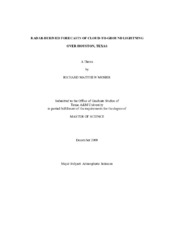| dc.description.abstract | Ten years (1997 - 2006) of summer (June, July, August) daytime (14 - 00 Z)
Weather Surveillance Radar - 1988 Doppler data for Houston, TX were examined to
determine the best radar-derived lightning forecasting predictors. Convective cells were
tracked using a modified version of the Storm Cell Identification and Tracking (SCIT)
algorithm and then correlated to cloud-to-ground lightning data from the National
Lightning Detection Network (NLDN).
Combinations of three radar reflectivity values (30, 35, and 40 dBZ) at four
isothermal levels (-10, -15, -20, and updraft -10 degrees C) and a new radar-derived product,
vertically integrated ice (VII), were used to optimize a radar-based lightning forecast
algorithm. Forecasts were also delineated by range and the number of times a cell was
identified and tracked by the modified SCIT algorithm. This study objectively analyzed
65,399 unique cells, and 1,028,510 to find the best lightning forecast criteria.
Results show that using 30 dBZ at the -20 degrees C isotherm on cells within 75 km of
the radar that have been tracked for at least 2 consecutive scan produces the best forecasts
with a critical success index (CSI) of 0.71. The best VII predictor was 0.734 kg m-2 on
cells within 75 km of the radar that have been tracked for at least 2 consecutive scans producing a CSI of 0.68. Results of this study further suggest that combining the radar
reflectivity and VII methods can result in a more accurate lightning forecast than either
method alone. | en |


